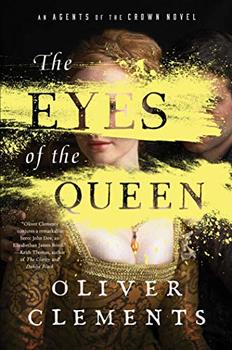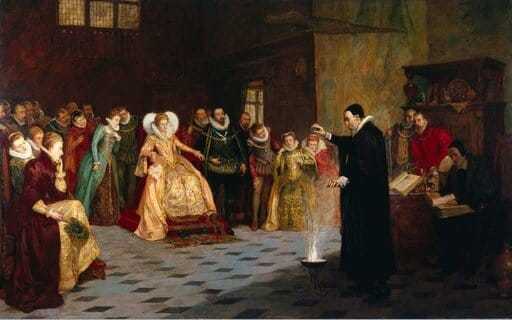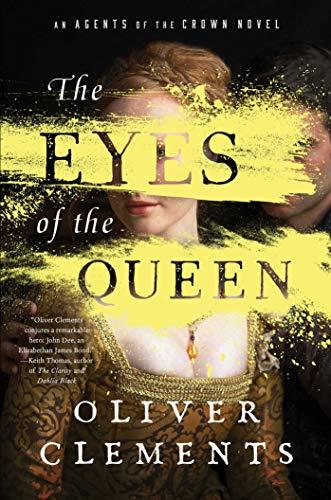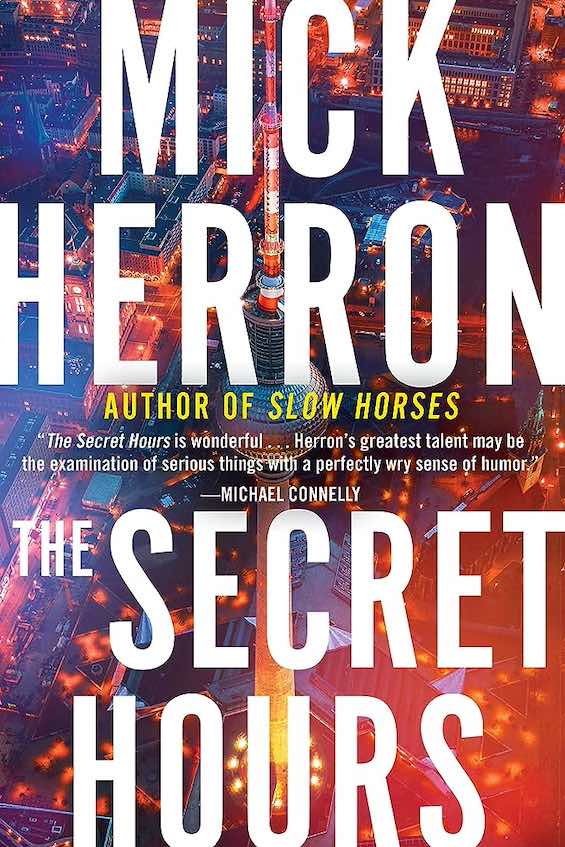
What is it with superheroes? Why have so many of us become obsessed with characters who transcend the boundaries of human ability? And why would an author of what might otherwise be a perfectly good spy thriller set in the Elizabethan era spoil it by endowing his protagonist with superhuman abilities? After all, people are trying to assassinate the queen! And when they fail, they’re going to try again and again. Isn’t it enough to tell a story about the fascinating men around her who work to prevent her murder? I wish it were so. But that’s not the case with Oliver Clements’ novel, The Eyes of the Queen.
The protagonist of this story, which Clements envisions as the debut of a new series of historical thrillers, is John Dee (1527-1608). Clements imagines him as a spy in the mold of James Bond. It’s true that later in the reign of Queen Elizabeth I (1533-1603), he was one of her “Watchers.” To Oliver Clements’ amusement, he even used the codename “007.” And during England’s war with Spain (1585-1604), he reported on developments in the Spanish court, among his other duties.
The Eyes of the Queen (Agents of the Crown #1) by Oliver Clements (2020) 303 pages ★★★½
However, at the time of the events in this novel (1572), Dee was merely the court astronomer and adviser to the queen. If there is any record of his having been involved in espionage with the queen’s spymaster, Francis Walsingham (1532-90), or in any scheme to infiltrate those who were trying to assassinate the queen at an earlier time, I’m unaware of it. In fact, Dee seems to have been entirely engrossed in astrology, alchemy, magic, the occult, and other delusions of the age.

A well-traveled historical backdrop
The historical backdrop of this novel is well-trod by historians and novelists alike. Queen Elizabeth came to England’s throne in 1558 after the successive deaths of her father, Henry VIII (1491-1547); her young half-brother, Edward VI (1537-53); and her half-sister, Mary Tudor (1516-58), who was known as Bloody Mary. Elizabeth was crowned instead of her younger half-sister, Queen Mary of Scots (1542-87). All those half-siblings and Marys were the product of several of Henry’s eight wives.
All this is very confusing, and it was further complicated by the ongoing struggle between Catholics and Protestants that came to the fore with Henry’s divorce and excommunication. Some of Henry’s wives were Protestant, others Catholic. Confusion aside, Elizabeth’s quandary was straightforward. Many in England considered Mary Queen of Scots to have a superior claim to the throne. And Mary had the support of her numerous Catholic coreligionists as well as the royal houses of France, Spain, and every other European power. They all owed allegiance to Rome. Unfortunately for Elizabeth, these forces played for keeps. They attempted on many occasions to assassinate her. And therein lies this tale.
The man who really was the “eyes of the Queen”
History tells us that Francis Walsingham served as Elizabeth’s Secretary of State and spymaster from 1573 to his death in 1590. He commanded a network of spies (the Watchers) whose principal duties were to keep an eye out for a possible Spanish invasion—and to ferret out the identities and intentions of the many men who conspired to assassinate the queen. In this novel, Clements fantasizes about John Dee playing a central role in Walsingham’s organization. Although that was not the case at the time, Walsingham did in fact serve as English ambassador to France in the early 1570s and witnessed the St. Bartholomew’s Day massacre, as the novel portrays. Other details also match the historical record, which only reinforces my disappointment about the distortion of John Dee’s story.
John Dee’s tale, according to the author
So, here then is that story as Clements tells it. Dee is dispatched to France on a mission to recover secret documents stolen from one of Walsingham’s agents. The documents are pages that were ripped from the log book of a Portuguese admiral. They purport to show the location of the fabled Northwest Passage from the Atlantic to the Pacific.
Demonstrating cunning and physical skill that are highly unlikely in an academic who spent most of his time in his legendary library, in an alchemical laboratory, and at his desk, Dee manages to snatch the heavily guarded pages after subduing heavily armed soldiers. And the story gets even harder to believe from that point onward. It’s sheer fantasy on a scale that Ian Fleming would have appreciated. To imagine that John Dee would thwart a plot to assassinate the queen through an adventure worthy of SEAL Team Six is just downright silly.
Now a word about the Northwest Passage, which is the MacGuffin of this novel. Until recently, there was no such route for commercial shipping, although the Norwegian explorer Roald Amundsen somehow managed to make the journey in the opening decade of the twentieth century. And the warming of the Arctic has lately opened up a window in summer. Ships can now traverse Canada’s northern reaches across the breadth of the North American continent from the Atlantic to the Pacific. The long-term geopolitical implications are significant.
For the record, I’ve been unable to learn anything about Oliver Clements other than than he wrote this novel.
For further reading
Other novels I’ve reviewed that explore espionage in Elizabethan England include To Shield the Queen (Ursula Blanchard #1) by Fiona Buckley (A worthy murder mystery set in the court of Queen Elizabeth I) and Murder by Misrule (Francis Bacon Mystery #1) by Anna Castle (A lawyer is murdered in the Elizabethan Age). I enjoyed both more than this one.
You may also want to check out:
- Top 10 historical mysteries and thrillers reviewed here
- The 10 top espionage novels reviewed on this site
- 20 most enlightening historical novels
- Top 10 mystery and thriller series
And you can always find my most popular reviews, and the most recent ones, plus a guide to this whole site, on the Home Page.



























